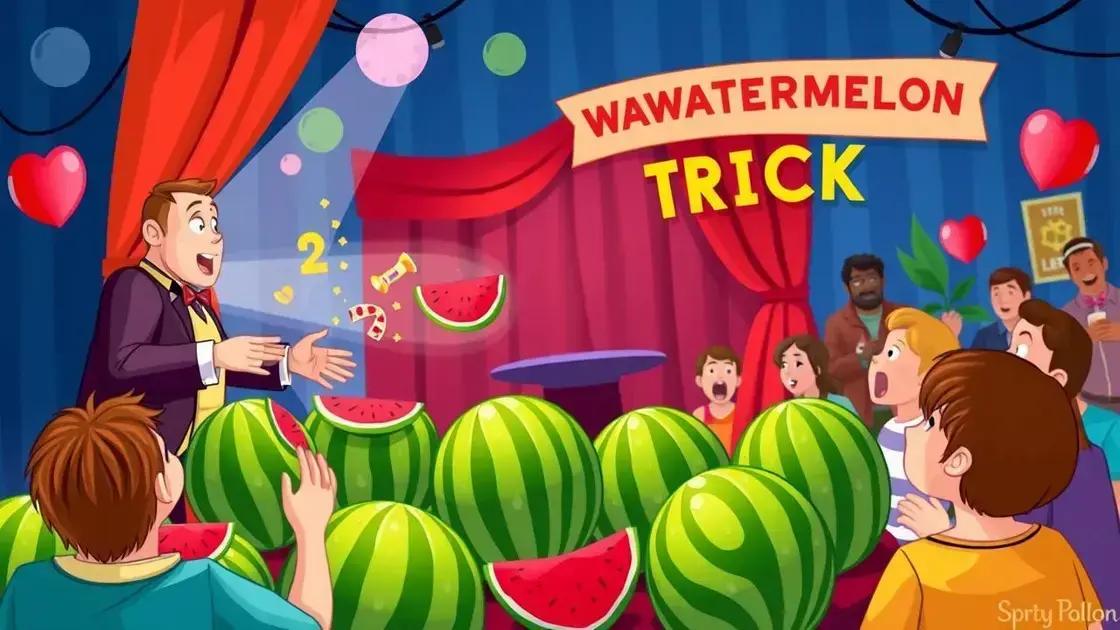The Watermelon Trick is a classic performance that captivates audiences with its humor and creativity. It has evolved over time, incorporating modern techniques and technologies while maintaining its cultural significance as a symbol of joy and celebration in various communities.
The Watermelon Trick has captivated audiences for generations. But what is the history behind this iconic performance? From its origins to its cultural significance, this trick has evolved over the years, becoming a staple in many performances. Join us as we delve into the details, examine the famous performers who brought it to life, and explore the modern variations that keep this fun act alive.
Origins of the Watermelon Trick

The Watermelon Trick finds its roots in traditional performance art and magic shows. This playful act involves tricking the audience into believing that a seemingly ordinary watermelon can become something extraordinary. Historical references suggest that this act originated in the early 20th century, when entertainers began to use food items in their performances.
Early Influences
Before settling on the watermelon, performers experimented with various items. Grapefruits and pumpkins were once common but did not captivate audiences as effectively. The watermelon, with its vibrant colors and juicy interior, provided the ideal canvas for creativity on stage.
Popularity Growth
As traveling circuses and vaudeville shows gained popularity, so did the Watermelon Trick. Its humor and surprise elements made it a favorite among performers. By the 1930s, acts utilizing this trick captivated audiences across America. Magicians and clowns added their twist to the act, creating new variations that thrilled participants.
Global Adaptations
The Watermelon Trick transcended cultural boundaries. In different countries, performers adapted the act to fit local tastes and customs. While the primary concept remains the same, variations in presentation and style have emerged. This adaptability contributes to the trick’s enduring appeal.
Today, the Watermelon Trick continues to inspire new generations of performers, proving that its origins are deeply tied to the creativity of entertainers seeking to amaze and amuse audiences everywhere.
Famous Performers of the Trick

Many performers have made the Watermelon Trick their signature act, bringing joy to audiences worldwide. One notable entertainer is David Copperfield, who introduced this playful trick in his magic shows. He seamlessly combined humor with impressive illusions, making the watermelon a star on stage.
Legacy of Comedic Performers
Comedians like Carrot Top have also embraced the Watermelon Trick. Known for his energetic performances, Carrot Top uses the watermelon to create comedic skits that keep audiences laughing. His unique style has brought a fresh twist to this classic act.
Street Performers and Festivals
Street performers have taken the Watermelon Trick to different levels, showcasing their talent at festivals. Jimbo the Clown is famous for his engaging street performances. He adds elements of surprise and improvisation, making each show unique. His ability to connect with the audience keeps them entertained and eagerly anticipating the next trick.
Modern Variations
In recent years, artists like Shin Lim, a world-renowned magician, have incorporated the Watermelon Trick into their acts in innovative ways. By blending traditional magic techniques with modern flair, they captivate audiences and bring new life to this classic performance. This evolution demonstrates how the Watermelon Trick continues to inspire performers today.
Cultural Significance

The Watermelon Trick holds cultural significance across various societies. It is more than just an entertaining performance; it represents joy and celebration. In many cultures, watermelons are symbols of happiness and summertime gatherings. Family reunions and festivals often feature this fruit, making the trick a fitting addition to such events.
Festivals and Celebrations
Watermelons often take center stage during summer celebrations. Events such as watermelon festivals celebrate this fruit with contests, games, and performances. The Watermelon Trick becomes a part of the festivities, enchanting audiences and bringing them together for laughter and fun.
Symbol of Resourcefulness
Performing the Watermelon Trick embodies resourcefulness and creativity. Entertainers showcase their ability to transform a simple object into something magical. This acts as a reminder of the importance of finding joy in everyday items and moments, resonating with audiences on a deeper level.
Community Bonding
In communities, the Watermelon Trick encourages social bonding. People gather around to watch the performance, sharing laughter and excitement. It fosters a sense of belonging, reminding individuals of the importance of connection through shared experiences.
Modern Variations of the Trick

Modern variations of the Watermelon Trick have emerged as performers experiment with techniques and presentations. Today, this classic trick is often part of larger performances that blend elements of comedy, magic, and audience participation. Innovative artists use the watermelon as a prop to engage viewers in creative ways.
Incorporating Technology
With advancements in technology, some performers have integrated LED lights and special effects into the Watermelon Trick. These enhancements create an eye-catching display that captivates audiences, bringing a fresh perspective to the trick. As a result, performances become more interactive and visually striking.
Audience Interaction
Modern acts often involve audience participation, making the Watermelon Trick more engaging. Performers invite audience members on stage to assist with the trick, creating a memorable experience. This type of interaction fosters connection and adds excitement to the performance.
Fusion of Art Forms
Some contemporary entertainers blend the Watermelon Trick with other art forms. Juggling, dancing, and acrobatics are combined to create a multi-faceted show. This fusion appeals to a broader range of spectators and keeps the performance dynamic and entertaining.
Through these modern variations, the Watermelon Trick continues to evolve while retaining its playful spirit. It showcases how performers can reinvent a classic act, keeping audiences delighted and intrigued.
In Summary: The Enduring Appeal of the Watermelon Trick
The Watermelon Trick has a rich history that captivates audiences across cultures and generations. From its whimsical origins to the modern variations we see today, this entertaining act serves as both a form of art and a symbol of joy.
Famous performers have brought this trick to life, showcasing their creativity and skill while making audiences laugh and marvel. Its cultural significance and ability to unite people further enhance its legacy.
As entertainers continue to innovate and adapt the Watermelon Trick, its playful spirit remains intact, proving that sometimes, the simplest acts can have the most profound impact.
FAQ – Frequently Asked Questions About the Watermelon Trick
What is the Watermelon Trick?
The Watermelon Trick is a classic performance art involving the transformation of a watermelon into unexpected forms, often accompanied by humor and audience engagement.
Who are some famous performers of the Watermelon Trick?
Several entertainers, including David Copperfield and Carrot Top, have famously included the Watermelon Trick in their performances, bringing creativity and laughter to audiences.
Why is the Watermelon Trick culturally significant?
The Watermelon Trick symbolizes joy and celebration in many cultures. It often appears at summer festivals, family reunions, and community events, fostering connection among people.
How has the Watermelon Trick evolved in modern performances?
Modern variations include the use of technology, audience participation, and fusion with other art forms like juggling and dancing, keeping the act dynamic and engaging.
Can the Watermelon Trick be performed at home?
Yes! With some creativity and preparation, anyone can try their hand at the Watermelon Trick at gatherings or parties, bringing fun and excitement to their friends.
What materials do I need to perform the Watermelon Trick?
You typically need a watermelon and some basic props for staging. Depending on the variation, additional tools like LED lights may enhance the performance.












